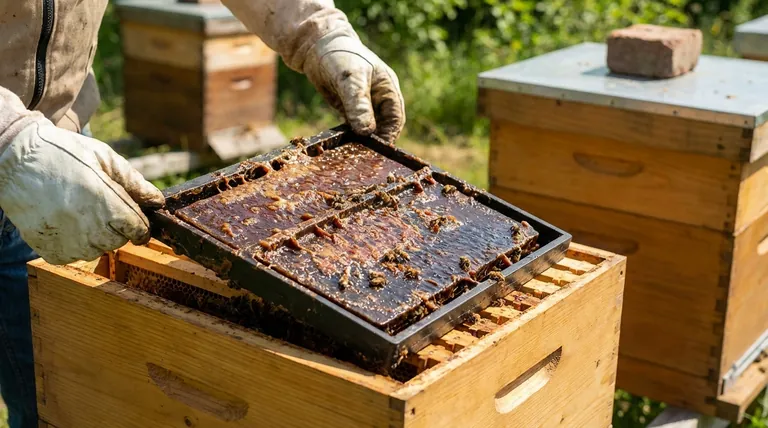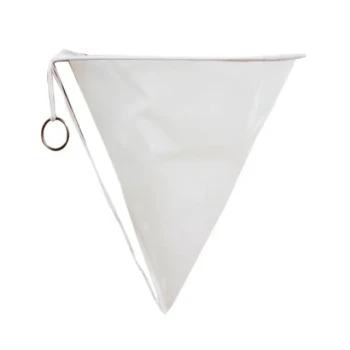The most effective method for harvesting propolis is by using a specialized tool known as a propolis trap or mat. This device, typically a flexible plastic screen with small gaps, is placed at the top of the hive. Because bees are instinctively driven to seal any cracks that allow drafts or light, they diligently fill these gaps with propolis, making collection clean and efficient.
The key to a successful harvest is not simply scraping propolis from hive components, but strategically encouraging bees to deposit it onto a removable trap. This method ensures a cleaner product and prioritizes the long-term health and stability of the colony.

Understanding Why Bees Produce Propolis
To harvest propolis effectively, you first need to understand the bees' motivation for creating it. This insight is the foundation of the entire process.
From Tree Resin to Hive Sealant
Bees create propolis by collecting resin from trees and plants. They carry this sticky substance back to the hive on their hind legs, much like they do with pollen.
Inside the hive, they mix this resin with their own enzymes and beeswax to create the final product: propolis. Its primary purpose is to act as a sealant, waterproofing agent, and structural reinforcement.
The Triggers for Propolis Production
Several conditions stimulate bees to produce and apply propolis. Understanding these triggers is what makes a propolis trap work.
Bees will apply propolis to seal cracks and gaps (typically smaller than a standard bee space), eliminate drafts, and block out any unwanted light. The design of a propolis trap exploits all three of these natural behaviors.
The Step-by-Step Harvesting Process
Harvesting is a straightforward process that works with the bees' natural tendencies, not against them.
Step 1: Assess Your Hive's Health
Before anything else, ensure your hive is strong, healthy, and thriving. Propolis collection is a secondary goal; the primary responsibility is the well-being of the colony. Only harvest from hives that are producing an excessive amount.
Step 2: Choose the Right Time
Propolis production naturally peaks in late summer and early autumn. This is when bees are instinctively preparing their hive for winter, sealing every last crack against the coming cold. Placing your trap during this period will yield the best results.
Step 3: Install the Propolis Trap
The trap, or mat, is placed directly on top of the uppermost hive box, just underneath the main hive lid. The small gaps in the trap allow light and air to enter, which the bees will immediately work to seal.
Step 4: Collect and Freeze the Trap
Once the bees have substantially filled the grooves in the trap, it's time for collection. Remove the trap from the hive.
To make the brittle propolis easy to remove, place the entire trap in a freezer for several hours. Freezing causes the propolis to become hard and lose its stickiness.
Step 5: Extract the Propolis
After freezing, simply twist or flex the plastic trap. The hardened propolis will crack and break away from the mat, falling off cleanly. The collected raw propolis is now ready for cleaning and processing.
Key Considerations for a Quality Harvest
A successful harvest is measured not just by quantity, but by quality and sustainability. Avoiding common pitfalls is crucial for both the final product and the health of your bees.
Prioritizing Hive Health and Sustainability
Never take all of a hive's propolis. The bees need it for insulation and structural integrity. Stop all harvesting in the fall to ensure the colony has ample reserves to seal their home properly for the winter.
Avoiding Chemical Contamination
This is a critical safety measure. Never harvest propolis from hives that have been treated with chemicals or miticides. These substances can accumulate in the propolis, contaminating the final product and rendering it unsafe for use.
Making the Right Choice for Your Goal
Your approach should align with your primary objective as a beekeeper.
- If your primary focus is maximum yield: Place traps on your strongest hives during the peak production window of late summer and early autumn to capitalize on the bees' winter preparations.
- If your primary focus is hive health and sustainability: Harvest propolis sparingly, only taking from hives with a clear excess, and always cease collection well before the first frost.
By working with your bees' natural instincts, you can harvest this valuable resource responsibly and effectively.
Summary Table:
| Step | Key Action | Purpose |
|---|---|---|
| 1. Assess Hive | Check colony is strong and healthy | Prioritize bee well-being over harvest |
| 2. Timing | Install trap in late summer/autumn | Capitalize on peak propolis production |
| 3. Install Trap | Place plastic mat under hive lid | Encourage bees to seal gaps with propolis |
| 4. Freeze Trap | Place filled trap in a freezer | Harden propolis for easy, clean removal |
| 5. Extract | Flex the frozen trap | Collect pure, brittle propolis chunks |
Ready to scale your propolis harvesting operation?
As a commercial apiary or beekeeping equipment distributor, you need reliable, high-volume solutions. HONESTBEE supplies the durable propolis traps and other essential beekeeping supplies you need for efficient, large-scale harvests.
We help you maximize yield while maintaining the highest standards of hive health. Let's discuss how our wholesale-focused operations can support your business goals.
Contact HONESTBEE today for expert advice and wholesale pricing on professional-grade beekeeping equipment.
Visual Guide

Related Products
- 8-Frame Electric Self-Reversing Honey Extractor Spinner for Commercial Honey Extraction Equipment
- 10L Stainless Steel Electric Honey Press Machine
- Plastic Hand Crank 2 Frame Honey Extractor Low Price
- HONESTBEE 6 Frame Three Use Electric Honey Extractor for Beekeeping
- HONESTBEE 72 Frame Industrial Electric Honey Extractor for Beekeeping
People Also Ask
- What is a honey extractor and how does it benefit beekeepers? Boost Honey Yield & Hive Health
- What factors should be considered when choosing the size of a honey extractor? Maximize Your Harvest Efficiency
- What factors should be considered when choosing a honey extractor machine? Maximize Your Harvest Efficiency
- Why is preserving honeycomb integrity important, and how do automated extractors help? Boost Hive Health & Honey Yields
- What size honey extractor is recommended for different hive sizes? Maximize Your Harvest Efficiency



















